Review: Trumpeter 1/32 TBD-1 Devastator
The Airplane:
From the beginning of carrier aviation, the torpedo had been seen as the best weapon for aircraft to use against warships, given the light explosive weight and inaccurate aiming of aerial bombs. Due to the technology of the torpedo itself at the time, lacking speed and range and being relatively delicate for a weapon to be dropped into the sea and then operate, such aircraft were limited to low speeds at low altitudes when attacking warships, making them incredibly vulnerable to anti-aircraft defenses when they had to fly in close to launch their weapon. The Japanese would resolve this problem by developing the Long-Lance torpedo, which had high speed and long range and was rugged enough to be dropped at high speed from a relatively high altitude. Sadly, the U.S. Navy, traditional to the end, failed to develop such a weapon and instead created what was likely the worst torpedo used by any navy in World War II, the Mark XII, which had low speed, short range and an unreliable trigger.
While the Bureau of Ordnance was busy screwing the pooch in the field of torpedo development, the naval aviators at the Bureau of Aeronautics were attempting to move heaven and earth to put forward specifications that would lead to the development of carrier based aircraft that were not hopelessly outclassed by their land-based contemporaries.
Their first breakthrough in this battle for modernization came in 1934 when the specifications included in the request for a modern torpedo bomber to replace the thoroughly-obsolete Martin T4M-1 biplane (also produced as the Great Lakes BT-1) that had equipped carrier-based torpedo squadrons since 1930, included increases in speed, range and operational capability. While a monoplane wasn't specified since such a demand would never make it past the conservatives who ran the Navy, the specification was such that a biplane would have difficulty in meeting the required performance.
Douglas Aircraft responded with a modern, all metal, low-wing monoplane design that was in advance of all other carrier-based aircraft anywhere in the world. Ordered as the TBD-1, the XTBD-1 prototype first flew in 1935. Powered by a 900 h.p. Pratt and Whitney R-1830, the clean three-seat aircraft had a then-phenomenal top speed of just over 200 mph. Following thorough trials in 1936 that completely demonstrated its compatibility with all the Navy fleet carriers, 129 TBD-1 “Devastator” torpedo bombers were delivered to the fleet between 1937-39, equipping all seven of the carrier air groups.
Sadly, the development did not include use of the newer, more high-powered developments of the R-1830, which had reached 1,200 h.p. by 1938. While the airplane was underpowered as a result, and sluggish in performance when mated to a 2,000-lb torpedo, Dick Best remembered it as a “nice-flying airplane” when not so burdened. The torpedo squadrons were considered so important, and the cachet of flying the most modern carrier aircraft in the world was such that even such a skilled aviator as Best had to “settle for” an assignment to dive bombers in 1940.
The revolution in aircraft design and subsequent performance that epitomized the decade before the outbreak of World War Two was such that - as with nearly every airplane ordered at the beginning of this period of increased creativity - the TBD that had been the cutting edge of naval aviation on first appearance was sadly obsolescent five years after it appeared on a carrier deck, when its time came to go to war. Its replacement, the Grumman TBF, was already in prototype development at the time of US entry into the war.
While today the TBD is remembered as mostly a “flying target” due to its performance at the Battle of Midway, the fact is that when it was used correctly, i.e., in coordinated attacks with high-altitude dive bombers and with proper fighter escort, the TBD was successful. At the Battle of the Coral Sea where the aircraft was used correctly, Devastators from the carriers Lexington and Yorktown sank the Japanese light carrier Shoho and damaged both of the Pearl Harbor veterans Shokaku and Zuikaku such that they were unable to participate in the Battle of Midway. The TBD was sent into battle at Midway without the diversion of dive bomber attacks and without fighter escort, allowing the defending Japanese fighters to go after them without competition. That they would be slaughtered as a result was something that should not have surprised anyone. Even the TBF that was the Devastator's replacement lost 3 of 4 attacking aircraft in similar conditions during the battle.
After Midway, the Navy had only 39 TBDs left. They continued to serve briefly in the Atlantic Fleet, before being transferred to training squadrons where they were used until late 1943. The 21 TBDs left at the start of 1944 were mainly employed as stationary hulks for maintainance training, and all were gone by the end of that year.
There are two TBDs known to exist in the Kwajalein lagoon where they were ditched after being shot up during raids in January 1942; sadly, the salt-water corrosion of the aluminum airframes is such that they can never be exposed to the atmosphere again. Another Devastator is known to be on the ocean floor off Cape Hatteras, at an ocean depth deep enough to have preserved the airframe. Sadly, the Navy has prevented this Devastator from being raised and restored. At least five TBDs are known to have crashed into Lake Michigan as a result of accidents aboard the training carriers Wolverine and Sable; if these could be found they would be easy to restore, since there is no corrosion in a freshwater environment.
The Kit:
Trumpeter first announced a 1/32 TBD in 2003. Over the 20 years since, it was largely dismissed as “vaporware” despite its continued listing in new catalogues. Finally, this past spring, it became known that the kit was real and would be released this
summer. With Trumpeter's up-and-down record on kit design over these past 20 years, modelers heard the news with a combination of hope and apprehension. Was it a product of the “A” team, or the “D” team?
Fortunately, it turns out that Trumpeter made the same production decision with this kit they did with their 1/32 SBDs: get the best 1/48 kit of the subject and scale it up; the SBDs are Accurate Miniatures kits upscaled, and this is the Great Wall Hobby TBD upscaled.
The kit is Trumpeter's usual first-class plastic molding. Fit is excellent and most modelers should be able to complete it with a minimum of filling and sanding, though the fuselage centerline will need some work as well as the mting surface between the fuselage and the rear area of the lower wing centerpiece. The surface detail is excellent, with raised ribs on the wing and tail surfaces and engraved detail elsewhere.
Two canopies are included - one fully closed and one with each section separate to be posed open.
Decals are included for two TBDs from VT-2: one in prewar “yellow wings” markings and one in early war blue-gray over light gray with red and white stripes on the rudder.
You cannot make a Midway TBD from this kit, since it does not include the twin-30 rear mount used by all three squadrons. An aftermarket company is reported to be making a 3D replacement part for that.
I obtained my kit from Squadron, which included an offer of decals from their Gold Medal Models line; there are three sets, including pre-war and wartime markings. I chose “Part 1" which is pre-war aircraft only and includes two options each from Lexington's VT-2 and Enterprise's VT-6.
Construction:
I began with the wing. The kit includes folded and open options and I chose open. I glued the upper wing parts together, using the bulkheads in each section and closing them up. I turned each wing on its upper surface and allowed them to set up overnight so there would be no droop. I then attached the lower center section and lastly the outer wing lower sections. The result is good and solid; I can pick the completed model up by a wingtip and it is fully solid.
I then turned to the cockpit. Recent research has revealed that the first 100 TBDs were originally delivered with the cockpits painted in overall aluminum lacquer; however, in March 1939 BuAer issued a memo calling for the cockpits to be painted overall Bronze Green at the next overhaul. Photos show the majority of aircraft were repainted by 1940-41, and all were repainted by the time of Pearl Harbor. I used Gunze Sangyo Mr. Color 519 “Bronzegrun” for this. Of note, while the paint callout for the fire extinguishers is for the bottles to be painted red, this was a post-war phenomenon. The fire extinguishers in TBDs were all polished brass, for which I used Vallejo Metallic paint “Brass.” I used the kit-supplied photoetch seabelts - do remember that the USN did not use shoulder harnesses until after Coral Sea.
I decided I would open the bomb aimer's doors in the lower nose, and have the torpedo stowage bay closed up, with yellow practice bombs; this was the usual configuration for the TBD pre-war (too bad they didn't make more torpedo drops, they might have been able to get the Mark XII fixed).
Once painted, the cockpit was assembled without difficulty and installed in the right fuselage half. I then closed up the fuselage. Once set, I saw I would need filler on the centerline seam for which I used CA glue.
Attaching the wing sub-assembly to the fuselage sub-assembly was easy, though the fit of lower center wing to lower rear fuselage required CA glue to fill it and get the area smooth. I rescribed detail and used my pounce wheel to rescribe rivet detail. I cut off the locator pins on the elevators so I could pose them “drooped.”
Trumpeter supplies a really nice R-1830 engine with a complete exhaust system. None of this can be seen when the cowling is attached. Displaying it open will require some effort to create an engine mount, which doesn't exist in the kit.
Painting:
I mixed a “Chrome Yellow” using Tamiya “Lemon Yellow” and “Orange” to match the color in the great Kodachrome-25 photos of TBDs aboard Enterprise in the summer of 1940, shot by Carl Mydans in bright daylight for Life magazine. After preparing the wings with flat white primer, I applied the Chrome Yellow. This wraps around the wing leading edge.
I matched Tamiya Gloss Red to the red of the decal by adding white paint, then painted the nose cowling ring.
I matched the blue in the Life photos using Tamiya X-4 Blue, adding white till I got to the color. I let these dry overnight, then masked them off and shot the fuselage and lower wing with Tamiya X-18 Semi-Gloss Black to prime for the metallic paint. When this was thoroughly dry, I used Vallejo metal colors “Semi-Matte Aluminum” for the aluminum lacquer color, misting that on to the model till the proper shade was achieved.
Fortunately, Trumpeter included precut masks for the canopy. I applied them, then painted the canopies with Bronze Green, then the Vallejo “Semi-Matte Aluminum.”
The propeller was painted Vallejo “Aluminum” and the landing gear was painted Vallejo “Steel.” The fabric covered ailerons were painted Vallejo “white Aluminum.” After this set up overnight, I unmasked everything.
Decals:
The GMM decals went on without problem. Fortunately GMM provided the proper wing chevrons for VT-6 TBDs, which had their wing chevron with the head “centered” on the fuselage centerline, unlike the other squadrons.
Final finish and assembly:
I airbrushed the upper wings, cowling band and the tail with Micro clear “Satin.” I then attached the landing gear. Trumpeter provides rubber tires, which modelers do not have to be afraid of; my two SBDs have had rubber tires since 2006, without any problems. I attached the bomb aimer doors open.
The canopies were posed in the open position. This is a little problematic for the “stack” of the assistant pilot canopy and gunner canopies, If I were doing this over, I would have the assistant pilot canopy closed; there's not that much to see in that cockpit anyway. The fit was tight enough that fumes from the CA glue I used resulted in a little fogging of the interior canopies, but it's not that noticeable unless I look closely. I attached the prop and called it done.
Overall:
This is not a difficult kit. Assembling it was actually easier than the Great Wall kit I did a few weeks ago. The result looks very nice and I am happy to finally have the model in my collection. Recommended for intermediate modelers and above.
Review kit courtesy of all you book buyers.
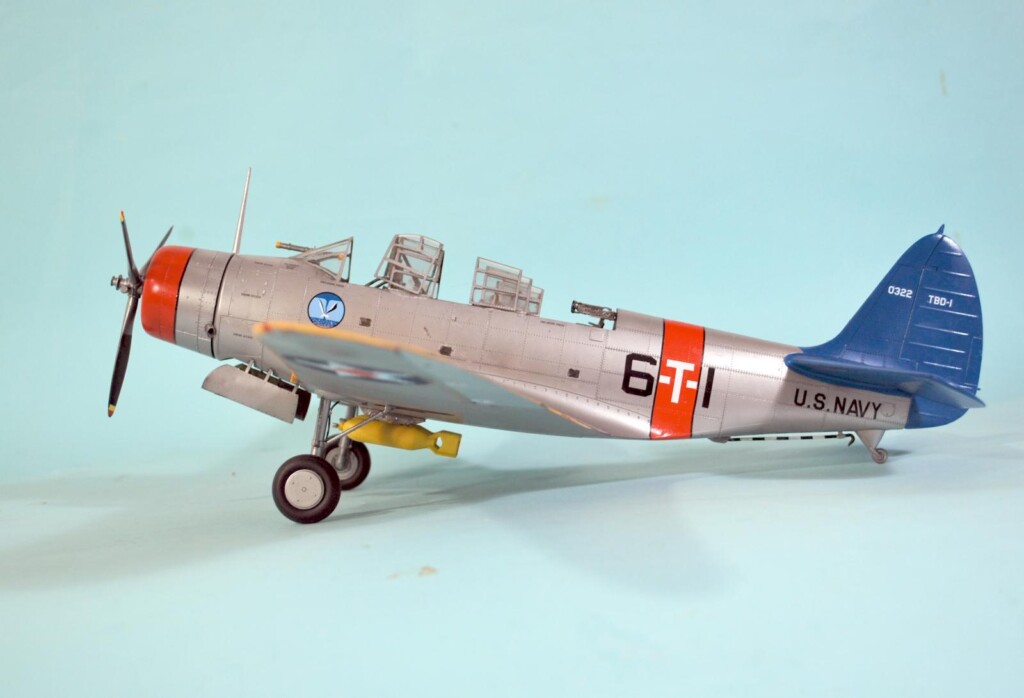

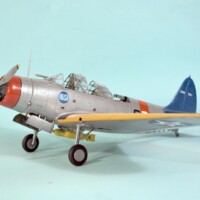
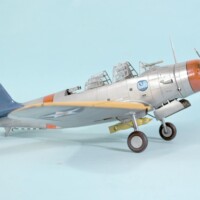
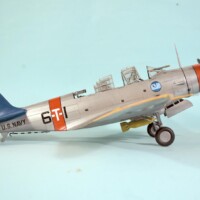
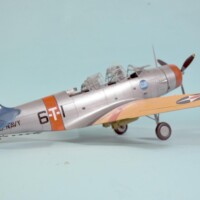
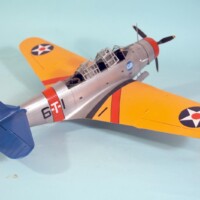

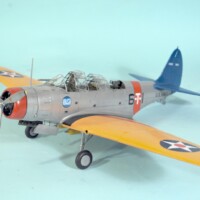

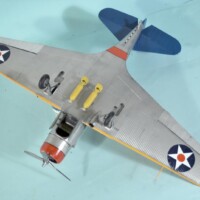
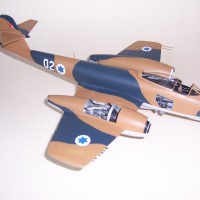
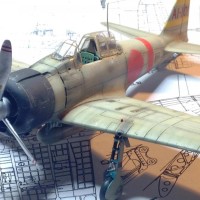
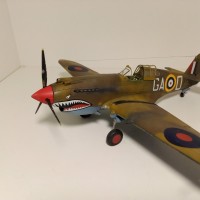

Beautiful job tom
Excellent Devastator. I like those pre war markings.
Brilliant result - an excellently put together Devastator and comprehensive history. One thing that always struck me about the Devastator (which I like as a subject) was it suffered from a common issue with others. That of expecting a single piston engine of that period to be able to lift 3 crew and a torpedo and deliver more than mediocre performance. The long lance was a ship born weapon only though. Japanese torpedo bombers carried 18" weapons and needed to get as close to US warships as Devastators.
The Japanese used the Type 93, which they could drop from 1,500 feet at a speed of 225mph. This was why they were so successful in torpedoing Lexington at Coral Sea and Yorktown at Midway, because the defending fighters were deployed at 800-1,000 feet in anticipation of a Devastator-style low altitude/low speed attack; the F4F didn't have the climb performance or speed to catch up to them before they dropped their torpedoes.
Hi Tom
That was the Type 91 - an 18 inch torpedo and the standard aerial torpedo for the IJN. The Type 93 was a 24 inch oxygen powered monstrosity that equipped cruisers and destroyers but was strictly for surface warships. It was a formidable weapon but as dangerous to its users as its targets (there is plenty of evidence of Long Lance torpedoes exploding on board and sinking Japanese warships). Yorktown was disabled by bombs and Type 91s and then sunk by a Type 95 submarine launched torpedo. Lexington succumbed to a combination of Type 91s and bombs.
That was fast! Nice work, Tom.
Very well done. Love the yellow wing scheme. It is too bad that the torpedo was not better developed.
I see you put the weights on the prop. Were they in the kit, did I miss something? I know they weren't on the instruction sheet.
The spread has started, one showed up at my other LHS. Hope they sell a lot.
Nope - put the weights on using cut-up sprue. That's the one big mistake in the kit.
This is one of my favorite planes and it looks best in the "Yellow Wings" paint scheme as you have done yours. I don't understand the logic the Navy is using as to why they are not more aggressively pursuing the planes left in Lake Michigan. There is an invasive species of "Oriental" muscle that has been basically taking over the waters there. They attach themselves to anything submerged, and they destroy aluminum when they become attached to it. The closest thing I can think of that is similar is a salt water barnacle. These are much larger than barnacles though. From what I have read, the way they entered these fresh waters is through shipping. They were likely brought here by trade vessels from the Orient. You can see them adhered to the raised aircraft in some of the pictures, However most of these photos are now over 20 years old, and the species is over populating the waters fast, taking over these regions with ease. It actually might be too late for many of these planes that once were excellent candidates for restoration.
I'm glad you picked up on the fire extinguisher colors. As a retired firefighter, I like that part of aviation history too. We had a 1942 Chevy 1.5 ton truck that was actually stationed at NAS Deland during the War. The department got it back from the Navy shortly after the War and they "restored" it and drive it during Christmas parades. It's a cool truck, even if it is painted the wrong colors... 😉
I stumbled across the brass fire extinguisher colors about 5 years ago when I built an old 1/48 Monogram TBD as part of the Midway group. Monogram instructions would have you paint them red too. My Devastator was built in the same colors as you have done yours in, a plane from the Enterprise. I built 6-T-6. Someday I would like to build the rest of the Monogram TBD kits I have in the stash. I think I have 4 or 5 of them left. Two will be Yellow Wings planes, one from Coral Sea and one for Midway.
Maybe then I'll grab one of these in 1/32. They look like awesome kits !
Thanks for sharing this one with us. I definitely clicked on a few of the "like" buttons.
The SBD-2 Pearl Harbor/Midway survivor that was pulled from Lake Michigan was sent to Planes of Fame at first for Fighter Rebuilders to restore in around 1997 (IIRC). It was covered in those mussels, and they didn't know how to get rid of them without damaging the airframe. I don't recall where it was then sent to, but they were the ones who figured out how to get them off the aluminum surface and were able to restore the airplane, which is now on display at the Pensacola Museum. That really looked like an unfixable mess when I first saw it.
Excellent result and ditto article, Tom!
Nicely done, Tom! Love the paint work.
Superb build, Tom @tcinla
It looks great in its yellow winged scheme.
First time I noticed the presence of bay doors at the nose of this aircraft.
Thanks a lot for sharing this great build and the supporting article.
Great build and article, you got to love those yellow wing paint schemes.
Beautiful TBD Tom @tcinla. I'm fascinated by the level-bombing aspect of the aircraft, how the middle crewman would climb down into the belly and sight the bombsite through the little open doors. If I ever build my GWH "Wake Island" kit I'll built it in the same configuration.
That's a good idea because all the TBDs in the Gilberts-Carolines strikes and the later Wake strike were used as horizontal bombers. (PS - the bombs should be gray in that case)
What a beauty,
Fantastic work.
Great work!